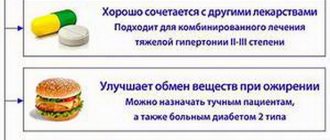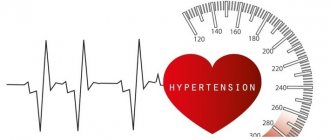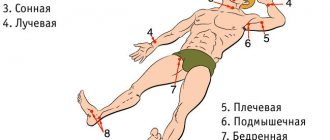Make an appointment by phone: +7 (343) 355-56-57
+7
- About the disease
- Cost of services
- Sign up
- About the disease
- Prices
- Sign up
Blood pressure (BP)
is one of the indicators of human health. Its increase is called arterial hypertension (AH). Hypertension is divided into hypertension (or true hypertension) and symptomatic hypertension (increased blood pressure due to a disease).
Normal blood pressure levels are 120/80 mm Hg. Art. Depending on the level, there are different degrees of hypertension. But the main criterion for the severity of hypertension is not so much high blood pressure as damage to target organs. They usually turn out to be those organs that have a well-developed vascular network and are well supplied with blood - the brain, retina, heart, kidneys, peripheral arteries of the lower extremities. That is why the degrees and stages of hypertension are distinguished, depending on the level of increase in blood pressure and damage to target organs, respectively.
But, regardless of the reason for the increase, hypertension always needs correction. It is necessary to distinguish between emergency, life-threatening increases in blood pressure and blood pressure that do not need urgent reduction.
An emergency, life-threatening increase in blood pressure accompanied by the following symptoms:
- intense headache, nausea, vomiting
- disturbance of consciousness
- visual impairment, hearing impairment, sudden onset
- shortness of breath, suffocation
- chest pain
- heart rhythm disturbances
- individually high blood pressure numbers recorded for the first time
- in older people. Since high blood pressure leads to the symptoms indicated in point 1
In the event of a life-threatening increase in blood pressure, you should immediately call an ambulance.
Dangerous symptoms
First aid for high blood pressure must be provided competently and immediately.
If there is no one nearby at this moment, a person who has an attack of hypertension should know how to behave in such a situation, waiting for the medical team. Often the patient simply does not notice high blood pressure. He may not feel any signs of ill health or, unknowingly, may not associate them with hypertension. This “negligent” attitude towards oneself is especially typical for people who are encountering a similar phenomenon for the first time. An asymptomatic course usually characterizes the initial stage of the disease. You can notice an increase in pressure only by measuring it. This can be done using a tonometer.
If the device shows numbers exceeding the permissible values of normal pressure (139/90), then the body has already sent the first alarm signal. Of course, this may be a one-time and minor rise, which sometimes happens to any person; it does not require medical attention. This can be checked by regularly measuring pressure over a certain period of time. Having noted episodes of periodic deviation of its indicators from the norm, one must seriously realize and accept the fact that one has hypertension.
In order not to miss the onset of hypertension, the following symptoms should not be ignored:
- headaches, which can be felt in any area, are strong and moderate, prolonged and paroxysmal;
- often pain in the head is associated with a feeling of nausea, vomiting is possible;
- the patient feels a buzzing in the ears, heaviness in the head, pulsation of blood in the temples;
- your head is spinning, the ground “goes away from under your feet,” your vision becomes dark, especially if you suddenly stand up from a sitting or lying position;
- the heart aches and hurts, you feel heat and heaviness in the chest, the pain can be squeezing;
- the heart rate becomes erratic or quickens;
- it becomes difficult to breathe, as if there is not enough air;
- fever or chills may appear, trembling in the limbs, arms and legs become numb and cold;
- blurred vision, flashing black spots appear before the eyes, difficulty focusing;
- there is pain in the eyeballs;
- possible nosebleeds;
- sleep problems;
- nervous excitement, manifested by irritation;
- apathy, loss of strength, lethargy, drowsiness.
Usually you can cope with the manifestations of hypertension on your own. Experienced hypertensive patients have a whole arsenal of proven medications for these cases.
But there are times when even they need emergency help for high blood pressure.
If the readings have increased to significant levels (30% above the usual level), you need to call an ambulance. For each person, the norm will be its own indicator; it may differ markedly from generally accepted standards (120/80).
One person will feel comfortable with a blood pressure of 135/85, while another lives with low blood pressure of 90/60 all his life. And for people with chronic hypertension, a slight increase in tonometer readings is practically the norm; the vessels have already adapted to this condition. Therefore, the concept of “high blood pressure” is quite relative. A hypotensive person will feel very bad already with readings of 140/90, and an experienced hypertensive person will call an ambulance if the pressure “jumps” to a level higher than 180/110.
The reason for providing first aid for hypertension should be the patient’s condition, and not the tonometer readings: if a person feels unwell, there is no one nearby, and he himself is not able to help himself, then an urgent need to call a doctor.
Poor health with pressure can be expressed by increased headache, vomiting, weakness bordering on fainting, the appearance of blurred vision, severe pain in the heart area. Symptoms that are typical for hypertension become pronounced, the person has a fear of death, it is difficult for him to breathe, and he becomes covered with red spots.
An emergency call to an ambulance will be needed if the medications taken and other measures to reduce blood pressure do not help, and also if the person has experienced an attack of hypertension for the first time.
A very dangerous phenomenon is a sudden sharp jump in indicators to high limits. This condition is called hypertensive crisis. In this case, first aid for high blood pressure should be provided immediately. What symptoms indicate danger:
- unbearable headache, weakness, nausea;
- arms, legs, face go numb, and often such symptoms are characteristic of one of the parts of the body: left or right;
- loss of vision.
These are signs of an incipient stroke, the outcome of which can be paralysis, coma, or death.
Here are the symptoms that precede the development of a heart attack:
- burning in the chest, not always in the heart area;
- pain extending into the arm, shoulder, or both arms;
- sometimes pain is felt in the jaw, teeth, shoulder blades or back;
- it becomes difficult to breathe;
- You may experience a feeling of a full stomach, heartburn, and your stomach begins to ache;
- interruptions in heart rhythm.
This is how acute heart failure manifests itself, which requires immediate medical attention:
- blueness of the tips of the fingers and toes, blueness in the lips;
- severe shortness of breath;
- arrhythmia;
- the appearance of pink foam at the mouth;
- coughing;
- heartache.
When complications of arterial hypertension develop, help is provided in different directions: reducing blood pressure and eliminating the symptoms of the accompanying complication. In this case, medications will be needed to support the heart muscle or relieve cerebral edema.
Clinical signs of high blood pressure
A tonometer is used to determine blood pressure readings. Normally, in a healthy adult, the level does not exceed the limits of 120-130 (for systolic) and 80-85 (for diastolic). The limit figures for people over 40 years of age are 145/90 units.
Symptoms of high blood pressure include:
- unreasonable anxiety, irritability;
- rapid heartbeat;
- fatigue, headaches;
- pulsation in the temporal zone;
- swelling, goose bumps;
- chills turning into hot flashes;
- sleep disturbances, dizziness.
The source of unstable blood pressure is due to many reasons, including psycho-emotional and physical stress. With a sudden increase in blood pressure, a hypertensive crisis may occur with irreversible consequences. Its symptoms are presented:
- severe redness of the facial skin;
- nervous excitement;
- painful sensations behind the sternum;
- hand tremors, decreased visual acuity;
- feeling of insufficient oxygen supply.
Calling an ambulance is justified when blood pressure increases to 160/95 units, but there are exceptions. For patients with hypertension, the critical level is 130/85. Referring to specialists is justified by additional factors and the presence of cumulative pathologies. An ambulance leaves for the first or repeated attack, the presence of symptoms of a hypertensive crisis, or the absence of a response to drugs prescribed to a patient with arterial hypertension.
Pills and medicines
A quick way to help a person is to give him the right pills. When deciding on the choice of medications that help with hypertension, you need to remember one important rule: a sharp drop in blood pressure can only worsen the situation. It must be reduced gradually. It is good to choose exactly those drugs, the effect of which appears a short time after administration, but the blood pressure will decrease smoothly, without jerks.
For hypertension, the following groups of drugs are used:
- Blockers of calcium ions, which settle on the walls of blood vessels, increasing their volume and causing an increase in pressure.
- ACE inhibitors (angiotensin-converting enzymes) block the production of an enzyme that, by causing certain transformations of substances in the body, contributes to an increase in blood pressure in humans.
- Diuretics are drugs that remove fluid from the body. They normalize kidney function, eliminate swelling, and reduce blood pressure.
All three groups of drugs complement each other well and act more effectively when used together. They are represented by the following drugs:
- "Amlodipine", "Felodipine".
- "Captopril", "Enalapril", "Fosinopril".
- "Hydrochlorothiazide", "Indapamide".
"Amlodipine" has a soft, smooth effect. Vascular resistance decreases slowly, which helps avoid increased heart rate. The drug is also used for ischemic heart diseases. Do not use in case of low blood pressure, cardiogenic shock, myocardial infarction. The use of these tablets may cause side effects: pain in the heart or head, increased appetite, frequent urination.
"Captopril" can be used as first aid for a person with high blood pressure, as well as for the systemic treatment of hypertension. Effectively lowers blood pressure to acceptable limits, effective within an hour or an hour and a half after administration. The drug does not contribute to fluid retention in the body, so it can be taken without diuretics. It facilitates the work of the heart and improves the functioning of the kidneys.
“Hydrochlorothiazide” removes fluid, relieves swelling in cases of high blood pressure, heart failure, and renal failure. Possible side effects: nausea, diarrhea, tachycardia, hyperglycemia, dizziness, blurred vision. It is not recommended for use in cases of liver failure, impaired renal function, or severe diabetes.
Apple cider vinegar - what is it?
Apple cider vinegar is a purified fermented mass of natural fruits with yeast or sugar. This healing composition is rich in useful minerals and trace elements; the main components can be noted:
- Potassium;
- Calcium;
- Boron;
- Sulfur;
- Iron;
- Phosphorus;
- Magnesium.
In addition, apple cider vinegar contains:
- Amino acids – stimulate metabolic processes;
- Active enzymes are cleansing components that serve to remove toxins and harmful impurities;
- Tannins – soothe irritated and tense vascular tissues;
- Beta-carotene – strengthens artery walls;
- Pectin – strengthens and restores tense and damaged areas of arteries and vessels;
- Vitamins of groups B and E.
The rich composition of the product allows you to gently stimulate the work of all major organs, normalize the body's metabolic processes at the cellular level and support human life.
Stages of emergency care
Emergency care for hypertension at home:
- You need to calm down. If self-hypnosis does not help, tinctures of valerian, motherwort, and hawthorn will help relieve a panic attack; you can take Corvalol or Validol, they will also help eliminate heart pain or arrhythmia. This must be done; increased nervous excitement intensifies the attack of hypertension. Nitroglycerin will also help relieve heart pain.
- A person needs to take a comfortable position, sit down or lie down, while the head should be raised, and on the contrary, it is better to lower the legs lower to ensure the flow of blood from the head to the legs.
- If there is trembling, the patient is shivering, his hands and feet are cold, he needs to warm up, cover himself with a blanket, and wrap his feet.
- To warm your feet, you can use a heating pad, a hot bath, put mustard plaster on your shins, or simply pour dry mustard into your socks. Heat is a good distraction procedure; it will help dilate blood vessels and force blood to drain from the vessels of the head to the peripheral ones. To relieve headaches and alleviate the general condition, you can put mustard plaster on the back of the head.
- Be sure to provide an influx of fresh air, preferably cool air, to do this, open all the vents and windows in the room.
- Remove restrictive clothing, unfasten all straps and buttons constricting your chest to make it easier to breathe.
- Take medications that lower blood pressure if this is not the first episode of high blood pressure and the pills have already been prescribed by a doctor; In this case, it is not worth experimenting with taking a new medicine. If an attack occurs for the first time, it is better to wait for a doctor, who will select medication, or consult an emergency doctor by phone.
How to make your own apple cider vinegar
The greatest benefit from taking natural vinegar will be if you prepare the composition yourself. This way you will be firmly confident that the mixture does not contain harmful additives or impurities, which means it is completely safe and harmless.
The only drawback in this recipe is the long aging time of the product; it takes 2 months to prepare, so for this period you will have to be content with a ready-made store-bought product.
- On a coarse grater you need to grate clean (pre-washed) apples in an amount of about 1 kg. When grating, you do not need to cut out the core and peel the peel; the vinegar is prepared from a whole apple (with seeds, skin).
- The apple mass is transferred to a glass container and filled with 1 liter of warm (not hot) water. You should also add 50 grams of honey or sugar.
- The container is covered with a layer of gauze and left in a dark place to stand for two weeks. The mixture should be shaken or shaken 1-2 times a day.
- After ½ month, the juice is squeezed into a clean container (it is recommended to use exclusively glass containers). If desired, you can again add 50 grams of honey or sugar.
- The procedure is repeated - the container should be covered with gauze and placed in a dark, cool place for quiet fermentation. The last stage takes from 1.5 to 2 months - until the liquid brightens and stops fermenting. The vinegar is ready, all that remains is to strain it.
Breathing exercises for lung recovery after COVID-19
Breathing exercises stimulate blood circulation, train the respiratory muscles, increase the elasticity of the lung tissue, and improve bronchial drainage. You need to perform gymnastics in a clean, ventilated room. Start with 30 seconds, gradually increase to a quarter of an hour. Overwork should be avoided. If you feel dizzy, take a break.
Preparatory exercises
- While lying on your back, inhale slowly for 3–4 seconds, then exhale the same slowly for 5–6 seconds.
- Diaphragmatic breathing, when the stomach “inflates” as you inhale.
- Slowly inhale air, slowly exhale through a straw into a glass of water, and relax. Repeat 2-3 times, gradually increase to 10 times.
Initial exercises
- Sit on a chair, press your back against the back of the chair, lower your arms down. As you inhale, gently raise your arms forward and then up. As you exhale, return to the starting position.
- The same exercise, only raise your arms up to the sides.
- Stand up, put your fingers on your shoulders. As you inhale, slowly spread your arms to the sides. Exhaling through your mouth, return to the starting position.
Basic exercises
Gymnastics by A. N. Strelnikova has proven itself well. It is difficult to master it on your own. It is necessary that the movements be shown by a person who knows the technique. Instead of this breathing exercise, your doctor may recommend another one.
General recommendations for lung rehabilitation after COVID-19
- Maintaining a daily routine, getting a full eight hours of sleep
- Moderate physical activity (10,000 steps per day - walks in the park, forest in dry and warm weather). On a cold, windy or rainy day, it is better to stay home. For a walk, dress according to the weather; shoes should be comfortable.
- Breathing exercises
- Daily wet cleaning and ventilation of the room.
- Refusal to visit the bathhouse or sauna. You should not take hot baths.
- Prohibition on drinking alcohol and smoking.
Physiotherapy after coronavirus
Table 3. Popular physiotherapeutic procedures
| № | Name | Action |
| 1. | SMT therapy | Sinusoidal modulated currents eliminate bronchospasms and improve drainage. |
| 2. | Laser therapy | Improves blood circulation, has a resolving and anti-inflammatory effect. |
| 3. | Polychromatic polarized light | Accelerates the resorption of infiltrate, improves bronchial patency. |
| 4. | Magnetotherapy | Eliminates inflammation, swelling, pain. |
| 5. | Ultrasound therapy | Removes phlegm, prevents the development of fibrosis. |











